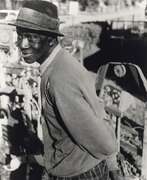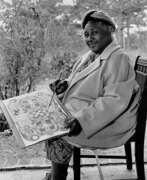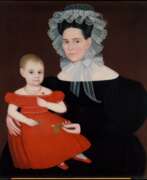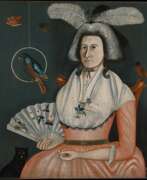USA Folk Art


William Matthew Prior was an American folk artist known for his portraits, particularly of families and children.
About 1,500 portraits are attributed to Prior. His works are in many museums and institutions around the United States including the Harvard Art Museums, Museum of Fine Arts, Boston, and the National Gallery of Art.


David Butler was an African American sculptor and painter from Good Hope, Louisiana. His style is epitomized by kinetic sculptures made from recycled tin or wood, which he embellished with saturated colors and geometric patterns. His work is now in the permanent collections of the Smithsonian American Art Museum, the American Folk Art Museum, and the Philadelphia Museum of Art.


James Castle was an American artist born in Garden Valley, Idaho. Although Castle did not know about the art world outside of his small community, his work ran parallel to the development of 20th-century art history. His works have been collected by major institutions. The Philadelphia Museum of Art organized a retrospective of Castle's work which toured nationally in 2008-09. Castle's work entered the international arena with a major exhibition in Madrid, Spain at the Museo Nacional Centro de Arte Reina Sofía in 2011 and was included in the 2013 Venice Biennale exhibition The Encyclopedic Palace. In 2014 The Smithsonian American Art Museum featured their recent acquisition in the exhibition Untitled: The Art of James Castle and the Whitney Museum of American Art included their acquired collection of Castle's work in the 2017 exhibition Where We Are.


Henry Joseph Darger was an American writer, novelist and artist who worked as a hospital custodian in Chicago, Illinois. He has become famous for his posthumously discovered 15.145-page fantasy novel manuscript called The Story of the Vivian Girls, in What Is Known as the Realms of the Unreal, of the Glandeco-Angelinian War Storm, Caused by the Child Slave Rebellion, along with several hundred drawings and watercolor illustrations for the story.
The visual subject matter of his work ranges from idyllic scenes in Edwardian interiors and tranquil flowered landscapes populated by children and fantastic creatures, to scenes of horrific terror and carnage depicting young children being tortured and massacred. Much of his artwork is mixed media with collage elements. Darger's artwork has become one of the most celebrated examples of outsider art.


Thornton Dial was a pioneering American artist who came to prominence in the late 1980s. Dial's body of work exhibits formal variety through expressive, densely composed assemblages of found materials, often executed on a monumental scale. His range of subjects embraces a broad sweep of history, from human rights to natural disasters and current events. Dial's works are widely held in American museums; ten of Dial's works were acquired by the Metropolitan Museum of Art in 2014.


Arthur Dial is an American painter and sculptor living and working in Bessemer, Alabama. He is a part of the Dial family of artists, which include his older brother, Thornton Dial, and his nephews, Thornton Dial Jr., Richard Dial, and Ronald Lockett.
Dial created reliefs and paintings that narrowed in on a specific moment within the broader narrative that he wished to convey. He uses these moments, such as Eve reaching for the forbidden fruit or "George Wallace blockading the entrance to the University of Alabama in Montgomery," to highlight historical or folkloric moments of extreme tension. Dial's focus on scenes of conflict in humanity's real or imagined history come from his direct observation of southern life throughout the 20th century. He describes his narratives as "a record of what went by".


Thomas "Sam" Doyle was an African-American artist from Saint Helena Island, South Carolina. His colorful paintings on sheet metal and wood recorded the history and people of St. Helena’s Gullah community.
Doyle's paintings and sculptures are held in the permanent collections of American Folk Art Museum, the High Museum of Art, the Smithsonian American Art Museum, the Gibbes Museum of Art and the Los Angeles County Museum of Art and Penn Center (Penn School on St. Helena Island).


Minnie Eva Evans was an African American artist who worked in the United States from the 1940s to the 1980s. Evans used different types of media in her work such as oils and graphite, but started with using wax and crayon. She was inspired to start drawing due to visions and dreams that she had all throughout her life, starting when she was a young girl. She is known as a southern folk artist and outsider artist as well as a surrealist and visionary artist.


Lee Godie (born Jamot Emily Godee) was an American self-taught artist who was active in Chicago during the late 1960s until around the early 1990s. She was a prolific artist who was known for her paintings and modified photos which are shown in galleries and museums such as the Hayward Gallery in London and the Smithsonian American Art Museum. She is often considered Chicago's most collected artist.


William Jennys was an American primitive portrait painter who was active from about 1790 to 1810. He traveled throughout New England seeking commissions in rural areas and small towns.
His early works are characterized by broadly modeled faces with a minimum of costume detail and bare backgrounds. Both the costumes and backgrounds became more detailed as his career progressed.


William Henry Johnson was a twentieth-century American artist. He is known as a primitivist painter.
William Johnson began his artistic career with realism, but then turned to primitivism and expressionism. He became famous for his works in the folk African-American style.
Johnson was an activist in the Harlem Renaissance cultural movement led by leading African American writers and artists.


Margaret Leisha Kilgallen was a San Francisco Bay Area artist who combined graffiti art, painting, and installation art. Though a contemporary artist, her work showed a strong influence from folk art. She was considered a central figure in the Bay Area Mission School art movement.


Sister Gertrude Morgan was a self-taught African-American artist, musician, poet and preacher. Sister Morgan achieved critical acclaim during her lifetime for her folk art paintings. Her work has been included in many groundbreaking exhibitions of visionary and folk art from the 1970s onwards.
Similar to other self-taught artists, Sister Morgan used simple forms to depict the human figure. Her works are characterized by their lack of the use of formal techniques such as perspective and definition of light and shadow, giving them a flat, two dimensional quality. She painted and drew using acrylics, tempera, ballpoint pen, watercolors, crayon, colored and lead pencils and felt tip markers. Using inexpensive materials she had at hand, Sister Morgan painted on paper, toilet rolls, plastic pitchers, paper megaphones, scrap wood, lampshades, paper fans and styrofoam trays. The fact that she was self-taught, coupled with her choice of materials as well as her style and subject matter have led her to be characterized as a naive, folk, visionary, vernacular and outsider artist.


Noah North was an itinerant American portrait painter in the folk art tradition.
His style is very simple and also reminiscent of the early New England limners. Many of his works feature people holding pets. His first dated portrait is from 1833, although it is identified as "number 11", which naturally suggest that ten paintings have been lost. No signed portraits are known from after 1840.


Sheldon Peck was an American folk artist, conductor on the Underground Railroad, and social activist. Peck's portraiture – with its distinctive style — is a prime example of 19th century American folk art. He also become known for advocating abolitionism , racial equality, temperance, public education, women's rights, and pacifism.


Ammi Phillips was a prolific American itinerant portrait painter active from the mid 1810s to the early 1860s in Connecticut, Massachusetts, and New York. His artwork is identified as folk art, primitive art, provincial art, and itinerant art without consensus among scholars, pointing to the enigmatic nature of his work and life. He is attributed to over eight hundred paintings, although only eleven are signed. While his paintings are formulaic in nature, Phillips paintings were under constant construction, evolving as he added or discarded what he found successful, while taking care to add personal details that spoke to the identity of those who hired him. He is most famous for his portraits of children in red, although children only account for ten percent of his entire body of work. The most well known of this series, Girl in Red Dress with Cat and Dog, would be sold for one million dollars, a first for folk art. His paintings hung mostly unidentified, spare for some recognition in the collections like those of Edward Duff Balken, for decades until his oeuvre was reconstructed by Barbara Holdridge and Larry Holdridge, collectors and students of American folk art, with the support of the art historian Mary Black. Ammi Phillip's body of work was expanded upon their discovery that the mysterious paintings of a "Kent Limner" and "Border Limner" were indeed his.


Elijah Pierce was a 20th-century wood carver. Pierce was the youngest in his family born from a former slave on a farm in Baldwyn. He began carving at a young age using a pocket knife. He first started carving animals because of his prior life of growing up on a farm. Pierce was honored with the National Heritage Fellowship for his art and influence in the woodcarving community in 1982.


Diego María de la Concepción Juan Nepomuceno Estanislao de la Rivera y Barrientos Acosta y Rodríguez, more commonly known as Diego Rivera, was a prominent Mexican painter celebrated for his critical role in establishing the Mexican mural movement both nationally and internationally. Born on December 8, 1886, in Guanajuato, Mexico, to a well-to-do family, Rivera was a child prodigy in art, encouraged by his parents from a young age after they noticed his penchant for drawing. This early support included installing chalkboards and canvases on the walls of their home to foster his talent.
Rivera's art was not just limited to murals; he was also a key figure in Mexican Cubism and had a rich body of easel paintings. However, his murals, depicting scenes of Mexican society and reflecting his leftist political views, remain his most notable contributions. Some of his most famous works include "Man at the Crossroads," which stirred controversy due to its inclusion of Lenin, leading to its destruction at the Rockefeller Center in New York. Rivera's murals are scattered across Mexico and the United States, serving as historical documents that highlight his technical skill and deep social engagement.
His personal life was as colorful and tumultuous as his art, marked by multiple marriages, including to fellow artist Frida Kahlo. Their relationship was both passionate and stormy, significantly influencing their respective works. Rivera's legacy extends beyond his artwork; he was a mentor to several artists and left an indelible mark on the art world with his contributions to public art and his political activism. His works have been declared national monuments by the Mexican government, underscoring his pivotal role in the country's cultural heritage.
For collectors and experts in art and antiques, Rivera's works offer not only aesthetic beauty but also deep social and historical insights. If you're passionate about adding a piece of this rich cultural heritage to your collection or staying updated on auction events related to Diego Rivera's art, signing up for updates can provide you with timely information on new sales and exhibitions featuring his masterpieces.


Nellie Mae Rowe was an African-American artist from Fayette County, Georgia. Although she is best known today for her colorful works on paper, Rowe worked across mediums, creating drawings, collages, altered photographs, hand-sewn dolls, home installations and sculptural environments. She was said to have an "instinctive understanding of the relation between color and form." Her work focuses on race, gender, domesticity, African-American folklore, and spiritual traditions.


Henry Speller was an American artist and blues musician working in Memphis, Tennessee. His style of drawing and painting is characterized by ornate, colorful, intimidating figures which he likened to "characters from Dallas".
Speller is best known for his drawings of detailed houses, modes of transportation (trains, cars, riverboats, and planes), and adorned figures, particularly women. His figures are often white women with angular faces, round breasts made of concentric circles, and exposed genitals with common southern white names, like "Katie Mae" and "Lisa Jean". Through these characters, Speller creates a metaphor for mobility and freedom in the Jim Crow South, which white women, and even some black women, can attain, but are inaccessible to him.


Tommy Wayne Cannon, also known as T. C. Cannon, was a 20th century American Indian artist.
In his work, T. C. Cannon often addressed themes of Native American identity, culture, and the impact of colonisation. He conveyed powerful messages of social and political significance in his paintings and prints.
Cannon's works are characterised by vivid colours, bold compositions and profound storytelling, leaving an indelible mark on the art world.


William Traylor was an African-American self-taught artist from Lowndes County, Alabama. Born into slavery, Traylor spent the majority of his life after emancipation as a sharecropper. It was only after 1939, following his move to Montgomery, Alabama, that Traylor began to draw. At the age of 85, he took up a pencil and a scrap of cardboard to document his recollections and observations. From 1939 to 1942, while working on the sidewalks of Montgomery, he produced nearly 1 500 pieces of art.
While Traylor received his first public exhibition in 1940, it was not until 30 years after his death that his work finally began to receive broader attention, in the late 1970s. Recent acceptance of Traylor as a significant figure of American folk and modern art has been founded on the efforts of Charles Shannon, as well as the evolving tastes of the art world. Shannon, who first encountered Traylor's work in 1940, brought Traylor to the attention of the larger art world. Traylor now holds a central position in the fields of "self-taught" and modern art.


Horace Clifford (Cliff) Westermann was an American sculptor and printmaker. His sculptures frequently incorporated traditional carpentry and marquetry techniques. From the late 1950s until his death in 1981, Westermann worked with a number of materials and formal devices to address a range of personal, literary, artistic, and pop-cultural references. The artist's sculptural oeuvre is distinguished by its intricate craftsmanship, in which wood, metal, glass, and other materials are laboriously hand-tooled, and by its ability to convey an offbeat, often humorous, individualistic sensibility.
Westermann's sculptures reveal not only the influence of craft traditions, but also of varied art historical precedents. The artist's ability to convey subtle and uncanny effects through the presentation of seemingly simple objects has often led critics to compare his work to that of Surrealist-inspired artists such as Joseph Cornell. However, Westermann's work encompasses elements from a broad and diverse range of artistic practices, including Assemblage, Dada, and Folk Art. His sculptures, moreover, point to minimal and post-minimal art of the late 1960s and beyond, in terms of their rigorous craftsmanship, formal sophistication, unconventional use of materials, and sense of humor.


George Widener is a self-taught artist who employs his mathematical/calculating capability to create art ranging from complex calendars and numerical palindromes to Rembrandt-like antiquarian landscapes to Asian scrolls.
Widener's work can be found in many private and public Outsider Art collections, including the Bruno Decharme ABCD Collection in Paris, The American Folk Art Museum, The Art Collection of the UC Davis M.I.N.D. Institute, and The Collection de l’Art Brut.





















































































